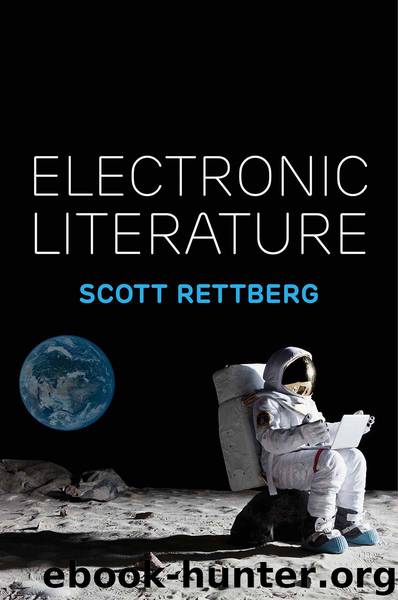Electronic Literature by Scott Rettberg;

Author:Scott Rettberg; [Rettberg, Scott]
Language: eng
Format: epub
ISBN: 9781509516810
Publisher: John Wiley & Sons, Inc.
Published: 2019-01-04T00:00:00+00:00
Symbolism, Futurism, and Lettrism
In his Un coup de dés jamais n’abolira le hasard (A Throw of the Dice Will Never Abolish Chance) (1897) Stéphane Mallarmé used varied typography, white space, and even the folds of the book to enable the reader to recombine different associations among the fragments of the text. The work is often cited as an antecedent to hypertext, as the relation between the fragments is not clearly dictated by the author but primarily constructed by the reader. Chris Funkhouser credits “the variations in typography, the integration of blank space, and the liberal scattering of lines” (Funkhouser, 2007, p.11) often found in digital poetry as derived from Mallarmé’s work and claims Mallarmé “gave poets permission to arrange poetry using inventive graphical methods” (Funkhouser, 2007, p. 87). Johanna Drucker points out that Mallarmé was appropriating design techniques that were already established in the graphic design of newspaper advertising of the period, and turning them to poetic expression (Drucker, 1994, p. 56). In some ways this appropriation anticipates kinetic poets who used Shockwave and Flash during the 1990s and 2000s, whose work was often developed in conversation with designers working in commercial forms.
Italian Futurism was an early twentieth-century poetry and art movement associated with the rise of fascism, which emphasized speed, technology, youth, violence, as well as the machines and industrialism of modernity. The leader of the futurist movement (and one of the authors of the first Fascist Manifesto) was the poet F. T. Marinetti. In the Manifesto of Futurism (1909), Marinetti attested that he was inspired to start the movement after a car crash in 1908 that threw him out of the Fiat he was driving head over heels into the ditch (Marinetti, 2002, p. 290). Marinetti used the space of the printed page to create a sense of speed and motion, and to foreground “parole in libertà” (word autonomy), abandoning meter and line to focus on juxtapositions of single words or letters with each other in the typographic space of the page. His Zang Tumb Tumb (1914) is a book-length work about the siege by the Bulgarians of Turkish Adrianople in the Balkan War, which Marinetti had witnessed as a war reporter. His inventive typography uses textual elements in different fonts arranged in different sizes and shapes on the page to represent the noises, speed, and chaos of battle. Marinetti wrote that he was calling for “a typographic revolution directed against the idiotic and nauseating concepts of the outdated and conventional book,” a revolution “directed against what is known as the typographic harmony of the page, which is contrary to the flux and movement of style.” If Marinetti’s ideology was disturbing, his uses of letterforms on the page to represent movement, speed, objects, and ruptures were influential for a number of subsequent literary movements engaged with the materiality of the written word. Marinetti also performed the work as sound poetry, presenting both language and sound as concrete materials that could more effectively represent ideas by using space, time, and shape, than they could be in regularly formatted print books.
Download
This site does not store any files on its server. We only index and link to content provided by other sites. Please contact the content providers to delete copyright contents if any and email us, we'll remove relevant links or contents immediately.
| Books & Reading | Comparative Literature |
| Criticism & Theory | Genres & Styles |
| Movements & Periods | Reference |
| Regional & Cultural | Women Authors |
4 3 2 1: A Novel by Paul Auster(11052)
The handmaid's tale by Margaret Atwood(6854)
Giovanni's Room by James Baldwin(5879)
Big Magic: Creative Living Beyond Fear by Elizabeth Gilbert(4723)
Asking the Right Questions: A Guide to Critical Thinking by M. Neil Browne & Stuart M. Keeley(4576)
On Writing A Memoir of the Craft by Stephen King(4214)
Ego Is the Enemy by Ryan Holiday(3991)
Ken Follett - World without end by Ken Follett(3973)
The Body: A Guide for Occupants by Bill Bryson(3802)
Bluets by Maggie Nelson(3711)
Adulting by Kelly Williams Brown(3671)
Guilty Pleasures by Laurell K Hamilton(3587)
Eat That Frog! by Brian Tracy(3514)
White Noise - A Novel by Don DeLillo(3436)
The Poetry of Pablo Neruda by Pablo Neruda(3367)
Alive: The Story of the Andes Survivors by Piers Paul Read(3311)
The Bookshop by Penelope Fitzgerald(3228)
The Book of Joy by Dalai Lama(3218)
Fingerprints of the Gods by Graham Hancock(3214)
